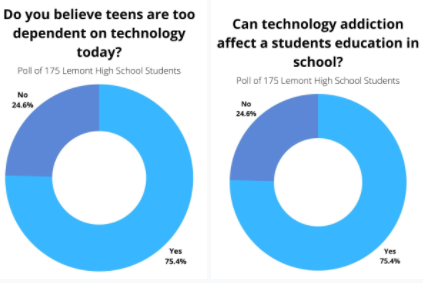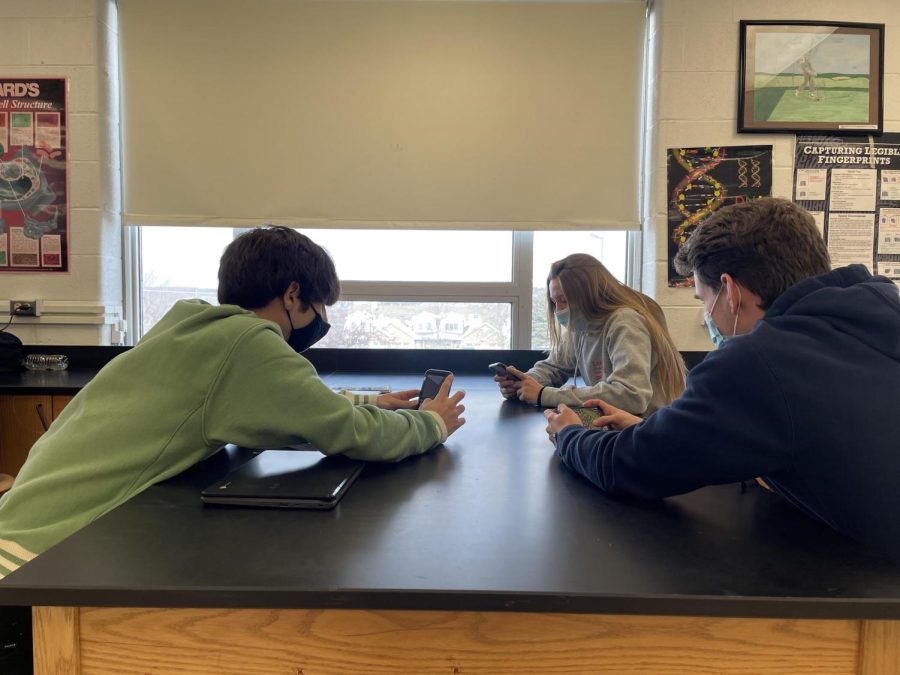Pandemic behind our screens
Seniors Van Gaetto, Joanna Machaj and Andrew Tilly sitting at their lab table in AP Biology awaiting class instruction.
February 7, 2022
There is no doubt today that society is deeply dependent on technology for our everyday lives. From school, work and connecting with friends and family, technology has brought forth the familiar interconnected world we all know. However, the growth of technology over time has led to many changes in the lives of teens today.
Technology addiction has plagued the minds of many around the world, but the most vulnerable to these problems are teens. Lemont High school students are no stranger to technology and have embraced the online learning environment throughout the COVID-19 pandemic. But technology addiction is a raging pandemic happening right now in our school and many others.

“I see some of my classmates keep their phones out when teachers tell them to put them away. It is just very disrespectful,” said senior Van Gaetto.
“I see a lot of my classmates denying their addiction to their phones when they clearly are affected,” said senior Joanna Machaj.
Technology addiction has caused many teens to become tied to their phones and struggle to remain focused while in school. Teachers have taken notice of this issue and how it has affected their students.
“This is my ninth year teaching and I believe it has been an issue since I have started, but I think it has definitely been an increasing problem over time,” said Spanish teacher Melissa Karigan. “I believe there are a lot more mental health issues [in students] and a lot of these stem from our phones.”
Students have also taken notice of an increase in this problem. “I have seen an increase in students on their phones in school and we always have our computers in front of us too,” said Machaj.
“After quarantine, I have seen an increase of students constantly on their phones in school during class, even when the teacher is talking,” said Gaetto.

“My teacher makes us put our phones in the back of the class,” said Gaetto. “It really keeps us engaged especially when we are in a lesson or doing a pear deck.”
“Teachers tell us to put our phones away at the beginning of class or tell us to put it in our backpacks,” said Machaj. “Some teachers tell us to put our backpacks against the wall but some students don’t listen.”
Some students believe teachers are not doing enough to combat the issue and want to see more action and sternness as a result.
“I think the teachers need to almost be more strict without being too strict because if the teachers are too much of a dictator the students tend to rebel more,” said sophomore Charlotte Drez.
Teachers take on the challenge of trying to balance a healthy relationship with students while also keeping them engaged in learning. Each individual student has different needs and teachers try to meet these individual needs as well as benefit the class environment.
“I started off this year with a challenge of trying not to look at your phone for a full period and it became sort of a rule,” said Karigan. “Especially with my freshman classes, I always have them start class with their phones in their bags and if I see it out I’ll ask them to put it on my desk until the end of class.”
Some students do not agree with the idea of teachers taking or separating them from their phones. Students believe that this behavior is risky and makes them uncomfortable in the classroom.
It is a teacher’s job to make sure that students always feel comfortable in their class and ready to learn. In order to quell this uncomforting fear students have, teachers are working hard to ensure that students are safe in the classroom and that they do not need to worry.
“Teachers can let worried students know what they do and what Mr. Gagnon [Assistant Principal] has put in place to increase safety,” said Karigan.
Other students feel more upset than anxious when teachers feel the need to take away their phones.
Empathising with students, Karigan said, “I understand how you are feeling because I also always want to look at my phone and I think about it a lot. Trying to break these habits is challenging but in the end it will pay off.”

“The ideal environment in my class this semester is an environment that is kind where students are kind to each other, where students are more present and engaged and where students are engaging with each other rather than their technology,” said Karigan. “We will still use Chromebooks of course but even so I would like to see more in person interaction rather than focusing on technology.”







